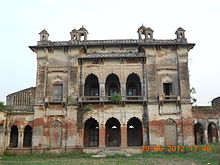Rajputs in Bihar
[4][5][6][7] Rajputs were pressed with the Zamindari abolition and Bhoodan movement in post-independence India; along with other Forward Castes, they lost their significant position in Bihar's agrarian society, leading to the rise of Other Backward Classes (OBCs).
[11] The immigration of Rajput clan chiefs into these parts of the Gangetic Plains also contributed to the agricultural appropriation of previously forested areas, especially in Southern Bihar.
[23] In the traditional agrarian society of Bihar in the pre-independence period, Rajputs were among the upper castes that controlled the agricultural production through Zamindari rights.
Rajputs, a less-literate relative of other upper castes, played a limited role in public administration and were primarily property holders.
[25][clarification needed] In post-independence India, pressed with the Zamindari abolition and Bhoodan movement, Rajputs and other upper castes lost their prominence in the agrarian society of Bihar.
[28] The Rajputs and Bhumihars and not the Brahmin and Kayastha being the major landowners among the upper castes is also supported by a study by sociologist Badri Narayan.
in a few villages in Bhojpur, rape of lower-caste women from Musahar and Chamar castes by Rajput and Bhumihar landlords was a major cause of anguish until the emergence of Naxalism.
[33] Ranabir Samaddar cited an example of an Anwa village in which upper-caste Rajputs practiced Dola Pratha; newly wedded brides of Dalits and landless labourers had to spend one night with the landlord before having sex with her husband.
[35]: 72–73 Later, assertion of many left-wing organizations took place in Bihar, the most prominent among them being Maoist Communist Centre of India (MCC), which waged wars against the landlords for the cause of lower castes.
[36] In the 1990s, the accession of Lalu Prasad Yadav to the premiership of Bihar brought socio-economic changes in the state's feudal society.
In the post-Mandal phase, Kurmi, Koeri and Yadav, the three backward castes who constitute the upper-OBC due to their advantageous position in the socio-economic sphere of agrarian society, became the new political elite of the state.
[40] Some of the leaders of the community also played important roles in the Rashtriya Janata Dal-led government, which includes Raghuvansh Prasad Singh, who conceptualised MNREGA, the biggest anti-poverty scheme in India.

